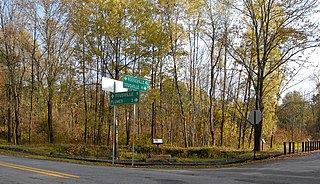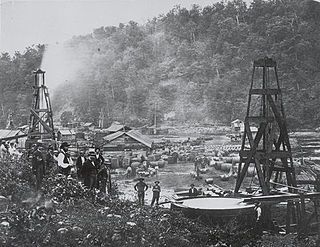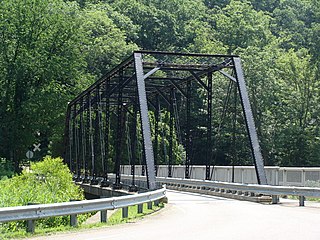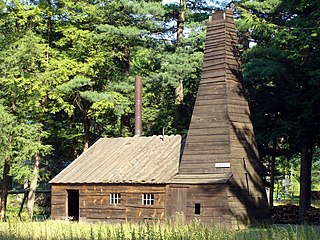Related Research Articles

Venango County is a county located in the Commonwealth of Pennsylvania. As of the 2010 census, the population was 54,984. Its county seat is Franklin. The county was created in 1800 and later organized in 1805.

Crawford County is a county located in the U.S. state of Pennsylvania. As of the 2020 census, the population was 83,938. Its county seat is Meadville. The county was created on March 12, 1800, from part of Allegheny County and named for Colonel William Crawford.

Oil Creek Township is a township in Crawford County, Pennsylvania, United States. The population was 1,708 at the 2020 census, a decrease from 1,877 at the 2010 census.

Titusville is a city in the far eastern corner of Crawford County, Pennsylvania, United States. The population was 5,601 at the 2010 census and an estimated 5,158 in 2019. Titusville is known as the birthplace of the American oil industry and for a number of years was the leading oil-producing region in the world. Titusville was notable for its lumber industry, including 17 sawmills, as well as its plastic and toolmaking industries.

Corry is a city in northwestern Pennsylvania, United States. With a population of 6,217 at the 2020 United States Census, it is the second largest city in Erie County. Corry is a part of the Erie, PA Metropolitan Statistical Area. The city became famous in the late-19th and early-20th centuries for being the manufacturer of Climax locomotives.

Oil City is a city in Venango County, Pennsylvania known for its prominence in the initial exploration and development of the petroleum industry. It is located at a bend in the Allegheny River at the mouth of Oil Creek.

Edwin Laurentine Drake, also known as Colonel Drake, was an American businessman and the first American to successfully drill for oil.

The Clarion River is a tributary of the Allegheny River, approximately 110 mi (177 km) long, in west central Pennsylvania in the United States. It drains a rugged area of the Allegheny Plateau in the Ohio River watershed, flowing through narrow serpentine valleys and hardwood forests.
McClintockville, Pennsylvania was a small community in Cornplanter Township in Venango County located in the state of Pennsylvania in the United States.

The Drake Well Museum and Park is a museum that interprets the birth of the American oil industry in 1859 by "Colonel" Edwin Drake along the banks of Oil Creek in Cherrytree Township, Venango County, Pennsylvania in the United States. The museum collects and preserves related artifacts. The reconstructed Drake Well demonstrates the first practical use of salt drilling techniques for the extraction of petroleum through an oil well. A historic site, the museum is located in Cherrytree Township, 3 miles (4.8 km) south of Titusville on Drake Well Road, situated between Pennsylvania Routes 8 and 27. The museum is accredited by the American Alliance of Museums.

Greater Pittsburgh is a populous region centered around its largest city and economic hub, Pittsburgh, Pennsylvania. The region encompasses Pittsburgh's urban core county, Allegheny, and six adjacent Pennsylvania counties in Western Pennsylvania which constitute the Pittsburgh, PA Metropolitan Statistical Area (MSA) as defined by the U.S. Census Bureau.

Pithole, or Pithole City, is a ghost town in Cornplanter Township, Venango County in Pennsylvania, about 6 miles (9.7 km) from Oil Creek State Park and the Drake Well Museum, the site of the first commercial oil well in the United States. Pithole's sudden growth and equally rapid decline, as well as its status as a "proving ground" of sorts for the burgeoning petroleum industry, made it one of the most famous of oil boomtowns.

Oil Creek State Park is a Pennsylvania state park on 6,250 acres (2,529 ha) in Cherrytree, Cornplanter and Oil Creek Townships, Venango County, Pennsylvania in the United States. The park is adjacent to Drake Well Museum, the site of the first successful commercial oil well in the United States, that was drilled under the direction of Colonel Edwin Drake. Oil Creek State Park follows Oil Creek, between Titusville and Oil City, and is on Pennsylvania Route 8. While the creek is the park's main recreational attraction, it also contains the sites of the first oil boomtown and much of Pennsylvania's original oil industry. The park contains a museum, tableaux, and trails to help visitors understand the history of the oil industry there, and an excursion train.

Oil Creek is a 46.7-mile (75.2 km) tributary of the Allegheny River in Venango and Crawford counties in the U.S. state of Pennsylvania. It has a drainage area of 319 square miles (830 km2) and joins the Allegheny at Oil City. Attractions along the river include the Drake Well Museum and Oil Creek State Park. The stream was named after the oil that was found along its banks before the historic oil strike by Edwin Drake in Titusville, which Oil Creek flows through. Oil Creek is popular with canoeists and fishers. The creek is rated as a beginners creek for those interested in learning how to safely use canoes and kayaks. Oil Creek is a cold water fishery with bass and trout living in its waters.

Conewago Creek is an 80.2-mile-long (129.1 km) tributary of the Susquehanna River in Adams and York counties in Pennsylvania in the United States, with its watershed also draining a small portion of Carroll County, Maryland. The source is at an elevation of 1,440 feet (440 m), east of Caledonia State Park, in Franklin Township in Adams County. The mouth is the confluence with the Susquehanna River at York Haven in York County at an elevation of 259 feet (79 m).

Petroleum Center is a populated place and ghost town in Cornplanter Township, Venango County, Pennsylvania, United States. In the 19th century, the name was also spelled "Petroleum Centre". The town today is almost deserted.

The oil rush in America started in Titusville, Pennsylvania, in the Oil Creek Valley when Edwin L. Drake struck "rock oil" there in 1859. Titusville and other towns on the shores of Oil Creek expanded rapidly as oil wells and refineries shot up across the region. Oil quickly became one of the most valuable commodities in the United States and railroads expanded into Western Pennsylvania to ship petroleum to the rest of the country.

The Jersey Bridge is a one-lane, Pratt through truss bridge that spans Oil Creek in Cherrytree Township, Venango County in the U.S. state of Pennsylvania. It connects the city of Titusville to the Drake Well Museum and Oil Creek State Park. The bridge was listed on the National Register of Historic Places in 1988. It was replaced in 1998 with a newer bridge that used the superstructure of the old bridge.

The Drake Well is a 69.5-foot-deep (21.2 m) oil well in Cherrytree Township, Venango County in the U.S. state of Pennsylvania, the success of which sparked the first oil boom in the United States. The well is the centerpiece of the Drake Well Museum located 3 miles (5 km) south of Titusville.
Pine Creek is a 13.8-mile (22.1 km) long tributary to Oil Creek in Crawford County, Pennsylvania. Most of Pine Creek and its tributaries are classed as Exceptional Value (EV) or High-quality-Cold Water Fishery (HQ-CWF). Only the lowest part of Pine Creek near Oil Creek is classed as a cold-water fishery.
References
- 1 2 "PA Oil Heritage Region". Oil Region Alliance. Retrieved 24 April 2012.
- ↑ Shaw, L. C.; W. F. Busch (June 1984). Pennsylvania Gazetteer of Streams, Part II. Water Resources Bulletin. Vol. 16. Prepared in Cooperation with the United States Department of the Interior Geological Survey. Harrisburg, PA: Pennsylvania Department of Forest and Waters. p. 270.
- ↑ "Authorizing Legislation". Oil Region Alliance. Retrieved 24 April 2012.
- ↑ ""Drake Well"". Friends of Drake Well, Inc. and the Pennsylvania Historical and Museum Commission . Retrieved 2007-11-09.
- ↑ "Pennsylvania Trail of History". Pennsylvania Historical and Museum Commission. Archived from the original on 2007-10-15. Retrieved 2007-11-09.